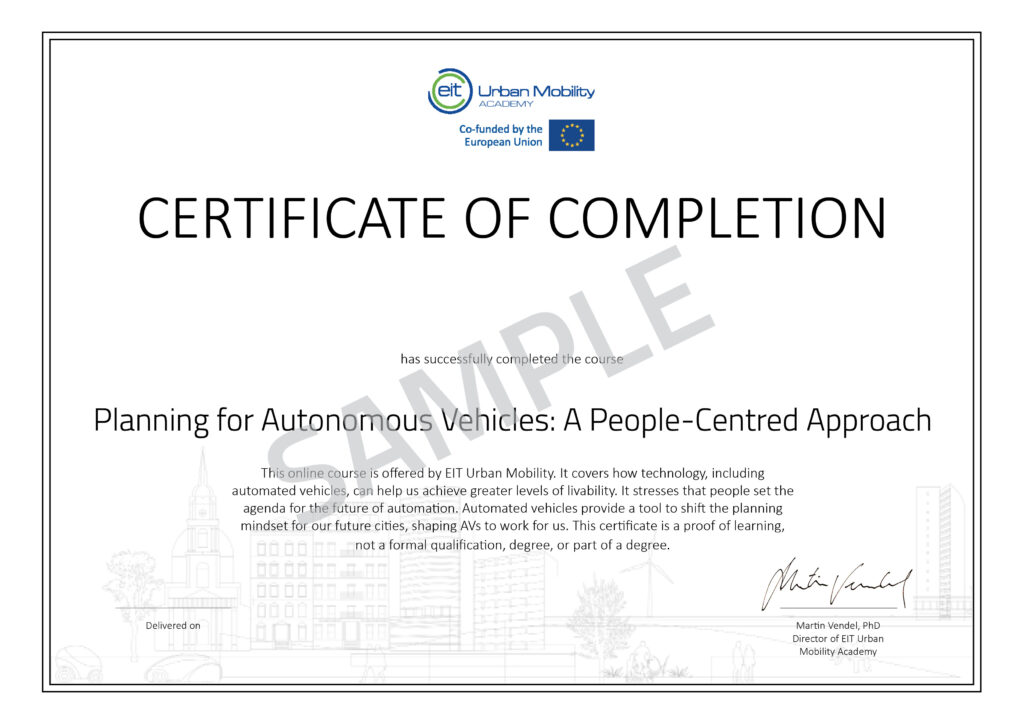Successfully incorporate autonomous vehicles into sustainable urban planning
For sustainable future cities, the way people use and move around urban spaces must be reviewed. The town planning done now will have massive impacts on city dwellers’ quality of life in the years to come. This course will explore how autonomous vehicles should be incorporated into sustainable urban planning. Its people-centred approach helps to ensure the systems are adopted, ultimately creating eco-friendly urban mobility for a greener tomorrow.
Discover the potential of autonomous vehicles
You’ll see what self-driving vehicles are capable of, beyond the hype. The training material will show you how to critically evaluate what the ‘automotive revolution’ promises for future cities and what, based on the technology, we can actually expect.
Let people determine the focus of sustainable transportation
The central idea of this course is that for clean, sustainable transportation systems to be successful, they need to meet people’s needs and be easy to use. Once you’ve understood the potential capabilities of automated vehicles, you’ll get to apply that knowledge to typical town planning challenges. Mobility requirements, general acceptance of new urban planning policies and transport systems, and other key obstacles will be explored.
In this course, you will:
– Critique reports and claims related to automated vehicles and other forms of “new mobility”
– Describe human, social and urban factors in planning decision making, in contrast to technical factors
– Reflect on potential second- and third-order impacts of the deployment of AVs
– Consider low-car ownership as an enabler of AV development in cities
– Develop a city plan outline, including plan staging, toward your stated end goals
Modules
Recommended schedule
Total length
Instructor

Bern Grush
Bern Grush is a Canadian transportation innovator and entrepreneur in the fields of automated vehicles, parking reform, road pricing. With a focus on Human Factors and Systems Design Engineering, he brings a unique urban sensitivity to vehicle automation from both a human-social perspective and a complex-systems perspective. Bern is co-author of the 2018 textbook “The End of Driving: Transportation Systems and Public Policy Planning for Autonomous Vehicles.” He is the inventor of Harmonize Mobility’s Rideal platform for transit-user micro-incentives being piloted in the EU, and project leader for ISO DTS 4448: “Ground-based automated mobility” for robotic ground-traffic operations.
About the course
Free & Paid Options
You can access and participate in the course for free. If you want to earn a certificate upon completion, you can purchase it. The certificate will be accessible only once the course is successfully completed. Read more here.

What Urban Professionals Have to Say
Course Content
Ratings and Reviews

User-Centered Design: Prioritize user needs for accessibility and safety. Urban Planning: Adapt cities for sustainable autonomous transport. Social Impact: Assess job changes and enhance accessibility. Safety and Trust: Ensure safety, build public trust transparently. Policy: Develop regulations prioritizing public well-being. Ethics: Address ethical concerns, involve the public.



I wasn't expecting the deep dive this course offers. Strong concepts and relevant resources given. The difference between private vs shared vehicles was made very clear. The course does repeat some points a bit often, and emphasis could shift a bit more towards emerging good practices. Perhaps also more indepth analysis of the technical challenges faced/progress by self-driving technology.